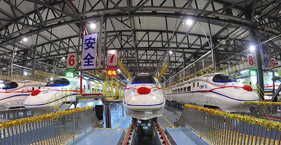Bejing to Britain or Berlin in two days on new high-speed rail network
Friday, 05 Apr, 2010
0

Passengers will be able to travel by train from UK to Beijing in just two days on trains that travel almost as fast as aeroplanes under ambitious new plans from the Chinese. China is in negotiations to build a high-speed rail network to India and Europe with trains that capable of running at over 200mph within the next ten years.
The network would eventually carry passengers from London to Beijing and then to Singapore. It would also run to India and Pakistan, according to Wang Mengshu, a member of the Chinese Academy of Engineering and a senior consultant on China’s domestic high-speed rail project.
A second project would see trains heading north through Russia to Germany and into the European railway system, and a third line will extend south to connect Vietnam, Thailand, Burma and Malaysia.
Passengers could board a train in London and step off in Beijing, 5,070 miles away as the crow flies, in just two days. They could go on to Singapore, 6,750 miles away, within three days.
"We are aiming for the trains to run almost as fast as aeroplanes," said Mr Wang. "The best case scenario is that the three networks will be completed in a decade," he added.
Mr Wang said that China was already in negotiations with 17 countries over the rail lines, which will draw together and open up the whole of Central, East and South East Asia. Mr Wang said the network would also allow China to transport valuable cargoes of raw materials more efficiently.
"It was not China that pushed the idea to start with," said Mr Wang. "It was the other countries that came to us, especially India. These countries cannot fully implement the construction of a high-speed rail network and they hoped to draw on our experience and technology," he said.
China is in the middle of a £480 billion domestic railway expansion project that aims to build nearly 19,000 miles of new railways in the next five years, connecting up all of its major cities with high-speed lines.
The world’s fastest train, the Harmony Express which has a top speed of nearly 250mph, was unveiled at the end of last year, between the cities of Wuhan and Guangzhou. Wholly Chinese-built, but using technology from Siemens and Kawasaki, the Harmony Express can cover 660 miles, the equivalent of a journey from London to Edinburgh and back, in just three hours.
Mr Wang said the route of the three lines had yet to be decided, but that construction for the South East Asian line had already begun in the southern province of Yunnan and that Burma was about to begin building its link. China has offered to bankroll the Burmese line in exchange for the country’s rich reserves of lithium, a metal widely used in batteries.
Currently, the only rail line that links China to South East Asia is an antiquated track built by the French in Vietnam a century ago. The Asian Development Bank has recently agreed a second £27 million loan as part of the £93 reconstruction of Cambodia’s network, which should finish by 2013. The cost of the lines from Cambodia to Singapore and then from Vietnam to China could be roughly £400 million.
"We have also already carried out the prospecting and survey work for the European network, and Central and Eastern European countries are keen for us to start," Mr Wang said. "The Northern network will be the third one to start, although China and Russia have already agreed on a high-speed line across Siberia, where one million Chinese already live."
One stumbling block is China’s desire for the high-speed tracks to run on the same gauge as China’s domestic network. Vietnam has agreed to change its standard gauge, but other countries are still in negotiations.
"From our point of view, the biggest issue is money," said Mr Wang. "We will use government money and bank loans, but the railways may also raise financing from the private sector and also from the host countries. We would actually prefer the other countries to pay in natural resources rather than make their own capital investment."
As for passengers, Mr Wang predicted that in a decade’s time, visa restrictions on travel through Asia "will be further lifted".
China’s new system connects the modern cities of Guangzhou and Wuhan at an average speed of 217mph – and it took just four years to build. The super-high-speed train reduces the 664-mile journey to just a three-hour ride and cuts the previous journey time by more than seven-and-a-half hours, the official Xinhua news agency said.
Work on the project began in 2005 as part of plans to expand a high-speed network aimed at eventually linking Guangzhou, a business hub in southern China near Hong Kong, with the capital Beijing, Xinhua added. ‘The train can go 245mph, it’s the fastest train in operation in the world,’ said Zhang Shuguang, head of the transport bureau at the railways ministry.
Test runs for the service began earlier in December and the link officially went into service when the first scheduled train left the eastern metropolis of Wuhan on Saturday.
By comparison, the average for high-speed trains in Japan was 150mph while in France it was 172mph, said Xu Fangliang, general engineer in charge of designing the link.
Beijing has an ambitious rail development programme aimed at increasing the national network from the current 53,437 miles to 74,564 miles, making it the most extensive rail system outside the United States.
China unveiled its first high-speed line at the time of the Beijing Olympics in 2008 – a service linking the capital with the port city of Tianjin.
In September, officials said they planned to build 42 high-speed lines by 2012 in a massive system overhaul as part of efforts to spur economic growth amid the global downturn.
Tickets for the service went on sale at new stations in the three cities last weekend, with prices ranging from 780 yuan (£71) for first class to 490 yuan (£45) for second class The link is expected to pose a real threat to airlines running flights linking the cities. High-speed rail has three advantages over air travel: it is more convenient, more punctual and has a better safety record
The network uses technology developed in co-operation with foreign firms such as Siemens, Bombardier and Alstom. Tickets for the service – which also stops at Changsha, capital of Hunan – went on sale at new stations in the three cities last weekend, with prices ranging from 780 yuan (£71) for first class to 490 yuan (£45) for second class, said a joint document released by the National Development.
The Shijiazhuang to Taiyuan link, also opened on April 1, caused sales for China Eastern Airlines’ Beijing to Taiyuan flight to slump 36 percent the following day, while private Spring Airlines reduced its Shanghai to Zhengzhou flights due to competition from the Shanghai bullet trains, Beijing News reported.
Valere
Have your say Cancel reply
Most Read
TRAINING & COMPETITION
 United Kingdom
United Kingdom United States
United States Asia Pacific
Asia Pacific












































Dozens fall ill in P&O Cruises ship outbreak
Boy falls to death on cruise ship
Turkish Airlines flight in emergency landing after pilot dies
Unexpected wave rocks cruise ship
Woman dies after going overboard in English Channel